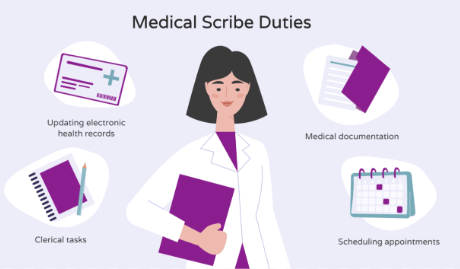A Manual for Remote Medical Scribe Responsibilities

The healthcare field constantly changes, with technological advancements transforming patient care and duties. One notable development is the emergence of scribes, who play a vital role in streamlining clinical processes, easing the documentation workload for healthcare professionals, and maintaining the accuracy of patient files. This handbook will delve into the tasks performed by scribes, the skills necessary for this position, and advice on excelling in this growing profession.
What Does a Remote Medical Scribe Do?
A remote medical scribe is a healthcare professional who documents patient interactions in time. They collaborate closely with doctors and other healthcare staff to ensure that all relevant information is accurately and promptly recorded in the patient’s health record (EHR). Remote medical scribes carry out these responsibilities from a location, from the healthcare facility, often working from their homes. This offers flexibility and enables them to assist multiple providers across different sites.
Key Responsibilities of a Remote Medical Scribe
Remote scribes are tasked with duties that enhance the efficiency and quality of healthcare services. The main tasks they handle include:
- Recording Patient Interactions: A key responsibility of a scribe is documenting patient encounters in real time. This involves noting the patient’s history, symptoms, exam results, test findings, consultations, and treatment plans. The scribe listens to the interaction between the doctor and patient via video or audio and inputs this data into the health record system.
- Maintaining EHRs: Virtual medical scribes ensure that all data entered into the EHR is precise, current, and compliant with regulations. They update patient records with details, rectify any inaccuracies, and ensure that the documentation meets the required standards of accuracy and thoroughness.
- Assisting with Coding and Billing: Though their focus is limited, many virtual medical scribes possess knowledge of medical coding and billing procedures. They aid in identifying ICD 10 and CPT codes for diagnoses and treatments for precise billing processes.
- Offering Administrative Support: Virtual medical scribes may also assist healthcare professionals.
In addition to managing appointments and correspondence, remote medical scribes coordinate referrals and oversee duties supporting a medical practice’s seamless functioning.
Essential Skills and Qualifications
To excel in their position, remote medical scribes require skills and qualifications including;
Medical Acumen: A firm grasp of terminology, anatomy, physiology, and joint health conditions is essential. Many remote medical scribes come from healthcare backgrounds, such as medical students, nursing students, or individuals with health sciences degrees.
Proficiency in Typing and Computer Usage: Since a significant portion of their tasks involve inputting data into Electronic Health Record (EHR) systems, remote medical scribes must possess typing skills and proficiency in computer usage. Familiarity with EHR platforms and software is also advantageous.
Attention to Precision: Accurate documentation is crucial in healthcare. Remote medical scribes must listen attentively, interpret information, and transcribe it meticulously. Any inaccuracies or omissions in documentation can impact care and billing processes.
Practical Communication Abilities: Scribes need strong communication skills. They should be able to clarify any uncertainties with healthcare providers by asking questions and conveying information succinctly.
Time Management Skills: Medical scribes must manage time efficiently and stay organized to carry out their responsibilities effectively. Remote medical scribes often manage documentation for patients and healthcare providers. These skills and the ability to manage time effectively are essential for ensuring that all tasks are completed promptly and to a high standard.
Certification
Although there isn’t a certification requirement for becoming a medical scribe, formal training can boost job opportunities and competence. Various organizations offer training programs and certifications for scribes, such as:
- The American College of Medical Scribe Specialists (ACMSS) offers the Certified Medical Scribe Professional (CMSP) credential, which entails completing a training program and passing an exam.
- The American Healthcare Documentation Professionals Group (AHDPG) provides the Certified Medical Scribe (CMS) program, including training and certification.
- Scribe America, one of the leading providers of medical scribe services, offers training programs and the chance to become a certified scribe through its organization.
- These programs typically cover terminology, anatomy, health record (EHR) navigation, legal and ethical considerations, and practical documentation skills
Advantages of Being a Remote Medical Scribe
Being a remote medical scribe comes with various benefits for both the scribes and healthcare providers:
- Flexibility: Remote medical scribes can work from anywhere with an internet connection, creating a schedule that fits their lifestyle and commitments. One advantage of being a scribe is the time and cost savings on commuting, which can positively impact work-life balance. For those interested in healthcare careers, working remotely as a medical scribe offers exposure to medicine and the chance to learn from experienced healthcare professionals.
- Managing documentation tasks: remote medical scribes help healthcare providers concentrate on care, ultimately enhancing the efficiency and quality of healthcare services. Despite its rewards, being a scribe presents challenges, such as ensuring reliable technology and internet access. Scribes should be prepared with plans for issues and possess basic troubleshooting skills.
- Creating a workspace at home: Is essential for timely documentation. Remote medical scribes should establish an area free of distractions to facilitate focused work. Challenges in Communication: When working remotely, there may be obstacles to communication between the scribe and the healthcare provider. Establishing communication channels and check-ins is essential to ensure smooth collaboration.
- Continuous Learning: The healthcare field is constantly changing, so remote medical scribes need to stay up to date on terminology, coding practices, and EHR technologies. Engaging in education and training is crucial for maintaining proficiency and offering top-notch support.
Success Strategies
To excel as a scribe, consider these tips:
- Invest in Good Equipment: Make sure you have a reliable computer, a fast internet connection, and any accessories needed (like a quality headset) for your job.
- Stay Organized: Use tools like calendars, task lists, and project management software to manage your responsibilities effectively.
- Ask for Feedback: Regularly seek input from healthcare professionals to enhance your documentation skills and address any issues they may raise.
- Embrace Professional Growth: Participate in training programs, workshops, or certification opportunities to improve your expertise and broaden your knowledge.
In conclusion
Remote medical scribes play a role in healthcare by assisting providers and enhancing patient care. With the help of a virtual assistant for doctors, scribes can streamline documentation processes and improve overall efficiency. Through training, communication, and solid organizational abilities, remote medical scribes can succeed in this expanding industry and positively impact healthcare service delivery. If you’re considering a career as a scribe, focus on continuous skill development and staying informed about industry developments to excel in this crucial role. Remember that precise documentation is essential for care and billing accuracy, so always aim for precision in your work. With commitment and effort, working as a scribe can be an incredibly fulfilling and rewarding journey.






